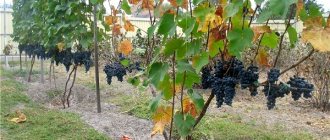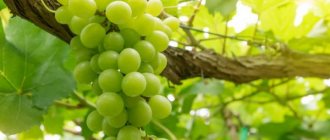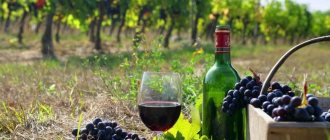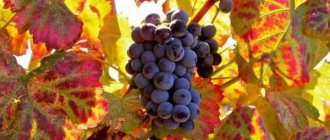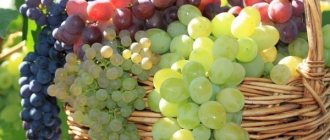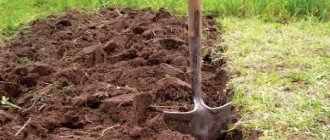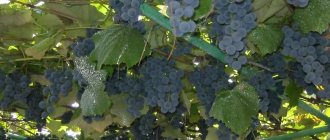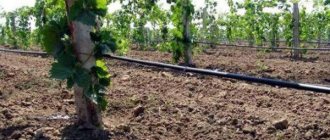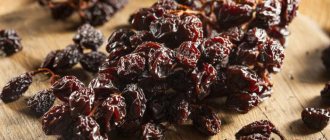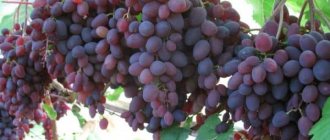Origin
The history of cultivation of Georgian grapes dates back to the 18th century. No one knows how the variety appeared. Most likely, human hands have nothing to do with this, and “saperavi” is a gift from nature itself. The variety was included in the State Register only in the middle of the last century, and in the late 80s it became known throughout the world thanks to its victory in the competition for the most aromatic grape varieties, leaving far behind its competitors from the USA, Australia and Japan.
“Saperavi” has been repeatedly used as a “parent” that gives life to new varieties. So he gave birth to “northern saperavi” - a variety artificially bred for the purpose of cultivating it in the northern latitudes of the country.
Main characteristics
“Saperavi” is a wine variety with an unsurpassed taste and aroma of berries that has won the hearts of many winegrowers and deserves the highest praise. Noteworthy technical varieties also include “Merlot”, “Marquette”, “Bianca”.
Ripening period
The date is considered late, since its growing season lasts about 150 - 160 days with a total of active temperatures of 2900ºС - 3000ºС.
Bush
The bush is medium-sized, 85% of the shoots ripen during the season, 70% of them bear fruit. The variety can be grown without a standard or with a low standard bush formation.
The leaves are light green in color, round or oval in shape, slightly dissected into 3 to 5 lobes, covered with thick hair on the underside. With the onset of autumn, the foliage begins to turn yellow, eventually becoming covered with rich red spots. The flower is bisexual, which allows the grower not to worry about pollination of the plant.
Attention! Often the leaves closely approach the clusters, blocking access to air and light. It is advisable to trim off excess leaves in a timely manner for normal fruit ripening.
Bunches and berries
The average weight of a “saperavi” brush is 90–110 g, dimensions are 13–17 cm by 12–15 cm, its shape is wide-conical, and its structure is loose.
The dark blue oval berries are quite small (18 by 17 mm) and light (4 - 6 grams), each of them has 2 seeds. When they are fully ripe, they acquire a thick whitish coating covering the skin. The peel is thin, but has a dense structure, which protects the berries from mechanical damage and damage by insects. The pulp is juicy, practically uncolored. Technical characteristics of the variety: sugar accumulation – 18 – 22%, acidity – 8 – 12 g/l.
Taste and yield
The taste of the berries is pleasant, harmonious, with notes of freshness and an unsurpassed aroma.
The highest yields are usually recorded in the homeland of grapes - in Kakheti - and reach 110 centners per hectare.
Botanical description
Grape variety "Saperavi" of medium-late ripening. The growing season lasts from 148 to 160 days. The bushes are harvested in October, when the berries have collected enough sugars and acidity has been reduced.
Flowering of this vine usually occurs with problems. A large percentage of ovaries crumble. Although the Saperavi grape flower is bisexual, incomplete pollination with peas on this bush is not uncommon.
The yield of this grape is high and amounts to 100 centners per hectare of vineyards. The variety is usually grown in the southern regions as a non-covering variety, however, during cold winters and negative temperatures below -21-23 degrees, a large number of fruit buds die. And even during unfavorable winters, replacement buds appear in the spring on the trunk and in the root zone of the plant; these buds also produce fruitful shoots, which is why the variety is distinguished by its stability in yield.
Comparison with analogues
Below is a comparison of “saperavi” with the most popular technical varieties of black grapes.
| Sign | Variety | |||
| Saperavi | Pinot Noir | Isabel | Zilga | |
| Ripening period | 150 – 160 days | 140 – 150 days | 150 – 180 days | 102 – 110 days |
| Frost resistance | -23C | -30C | -27С | -32C |
| Productivity | 80 – 110 c/ha | 50 – 60 c/ha | 60 – 75 c/ha | 300 – 400 c/ha |
| Bunches | Up to 110 g | 65 – 120 g | Up to 250 g | 200 – 400 g |
| Taste | Harmonious with notes of freshness | Harmonious delicate taste | Strawberry flavor | Isabelle taste and aroma |
| Color | Dark blue | Dark blue | Blue-black | Blue |
| Disease resistance | Average | Below average | Above average | Average |
| Shelf life | 3 – 4 months | 3 – 4 months | 3 – 4 months | 3 – 4 months |
| Sugar accumulation | 18 – 22% | 17 – 19% | 16 – 18% | 18 – 20% |
| Acidity | 8 - 12 g/l | 7 – 8 g/l | 6 – 7 g/l | 4 – 7 g/l |
Growing season.
From the beginning of the opening of the eyes to the technical maturity of the grapes intended for making table wines, an average of 141 days pass. The grapes are usually harvested in the second or third decade of September. The vigor of the bushes is average or weak. Annual shoots ripen satisfactorily. The yield is very high and stable. On average 115.3 c/ha, minimum 72 c/ha. There are 75-80% fruitful shoots; there are often an average of 1-1.4 clusters per shoot, and 1.6-1.8 clusters per fruitful shoot. When harvesting is delayed, berries fall off.
Beneficial features
“Saperavi” has long been considered a medicinal variety, since the chemical composition of the berries includes almost the entire complex of useful vitamins, microelements and amino acids necessary for the human body. This variety is easily absorbed by the digestive system. Once in the body, the “components” of grapes begin to take an active part in vital processes. Thus, methionine regulates fat metabolism, arginine stimulates the production of urea, lysine accelerates growth processes. And pectins actively remove toxins and heavy metal salts.
Saperavi berries are among the highest in calories: 100 g contains up to 100 kcal. Consuming them in large quantities is not recommended for overweight people, people with diabetes, and those with a history of serious gastrointestinal and kidney diseases.
What kind of wines are made?
The Saperavi variety is an excellent raw material for the production of high-quality wines and wine materials for sparkling wine. Its value is due to the high concentration of tannins and coloring pigment in the berries. That is why the wines have a deep dark garnet color, high alcohol and acid content, completeness and originality of taste.
The variety is used in winemaking by the most famous Georgian producers: Badagoni, Shumi, Graneli, Kindzmarauli-marani, Zegaan winery. Based on it, about 40 varieties of wine are produced, which can be divided into the following groups: table red single wines (Saperavi, produced since 1937), dessert red vintage wines (Saperavi Levokumskoye, which has been produced in the Stavropol Territory since 1949 ), strong dessert wines (“Cahors Yuzhberezhny”, produced in Crimea at the Massandra plant since 1933). A couple more well-known varieties: “Saperavi Akhasheni” and “Alazani Valley”.
Attention! After drinking wine or juice made from “saperavi”, the lips, mouth and teeth turn red. If such a reaction is not observed, then the liquid drunk has nothing to do with this grape variety.
History of the variety
One of the best and most common multi-purpose grape varieties is Saperavi. This grape of Georgian origin is considered one of the most ancient grape varieties of the Black Sea basin. There is also its Russian name - “Dyer”, which was given to the variety for the high content of coloring pigments in the skin. When we talk about grape varieties, we always think about winemaking.
“Saperavi” is very rich in doubles, for example “Saperavi Budeshuriseburi”. This twin is distinguished by a more elongated oval berry, as well as earlier (140 days) ripening time and intensity of sugar accumulation.
The grape variety “Krasilshchik” was successfully used as material for genetic selection. With his participation, a hybrid form with improved varietal characteristics, “Northern Saperavi,” was obtained at the Potapenko Novocherkassk Institute of Viticulture. We will also tell you more about it in this article.
Features of cultivation
The Saperavi variety is ideal for planting in the southern regions and is considered a market variety that tolerates transportation well and has a good presentation.
Landing
Grapes can be propagated in autumn (October) and spring (March - April). The main thing is that the air temperature is kept at +15ºС and above, and the soil temperature – +10ºС and above.
Since “saperavi” bushes can grow in one place for up to 25 years, the issue of choosing a suitable site should be approached with all responsibility.
A southern plant, accustomed to an abundance of sunlight, needs a site well warmed by the sun and protected from drafts and cold winds. For this reason, you should not plant the “saperavi” bush near tall buildings and trees that will shade the area where the grapes grow.
The preferred type of soil is clayey or slightly calcareous, the pH of which is 7. But on salty, highly calcareous and swampy soils, the winegrower cannot expect a harvest.
Young seedlings take root easily. But it is still necessary to follow a number of recommendations for planting:
- The dimensions of the planting hole should be within 60 x 60 x 60 cm, and the distance between neighboring bushes should be 1.5 - 2 meters.
- Be sure to fill the bottom of the hole with a layer of drainage (gravel, crushed stone, broken brick).
- The next layer is soil mixed with sand and organic fertilizers.
- You must immediately install a support to which the seedling will be tied.
The technology for planting seedlings of this variety is no different from the classical one.
Watering and fertilizing
“Saperavi” does not like large amounts of moisture, so experienced winegrowers recommend watering only 3–4 times per season with 2–3 buckets of sun-warmed water at a time. To preserve moisture and to prevent the formation of a dense crust on the surface of the soil, it is better to mulch the soil under the bush with sawdust, mown grass, and hay.
In spring, the plant needs to be fertilized with nitrogen, which will stimulate the growth of green mass. The procedure is carried out before flowering. It is important not to overdo it with the concentration of substances and the number of procedures performed, otherwise the ripening period may be delayed. Until mid-summer, the plant can be fed with organic matter; bird droppings are quite suitable for these purposes, and during the ripening period of the berries, fertilizers rich in phosphorus and potassium are ideal. Read more about the feeding calendar in a separate article.
Trimming
“Saperavi” needs annual pruning, which is usually done in the fall. Each shoot must be shortened by 3 to 5 buds. The recommended total load on the bush is 17 - 30 buds.
In the spring, during the flowering of grapes, it is necessary to ensure that 5–7 inflorescences remain on the fruitful shoot, which in the future will become full-fledged clusters. Excess brushes on the bush leads to its overload, which will negatively affect the quality of the berries and may threaten the death of the plant.
In summer, you should thin out the foliage and remove the shoots. Otherwise, the grapes will not ripen for a long time, and fungal diseases will sooner or later overcome the bush.
Diseases and pests
“Saperavi” has average resistance to diseases: the plant can easily “catch” mildew, oidium, and gray rot. To prevent such phenomena, it is necessary to regularly (4-6 times per season) treat the bush with fungicides or various substances. Thus, mildew will be prevented by Bordeaux mixture, oidium by a solution of colloidal sulfur, and gray rot by baking soda. Treatment is usually carried out before and after flowering, as well as before the berries begin to ripen. But the variety is highly resistant to chlorosis.
Of the pests, the most dangerous is phylloxera, which can be controlled with purchased insecticides and removal of affected parts of the plant. The leaf roller rarely settles on this variety.
Important! To prevent the spread of a fungal disease to neighboring bushes, it is advisable to treat not only the plant itself, but also the soil around it with fungicides.
Wintering
“Saperavi” loves warmth, but the plant can survive temperatures dropping to -23ºС. However, in regions with a temperate climate, grapes need additional insulation (spruce branches, dry leaves or agrofibre). In southern latitudes, only young seedlings should be covered, but mature bushes can be left without any insulation measures. Fortunately, frosts in these regions are rare and not so severe.
Harvest storage
The dense peel covering the berries prevents damage to their integrity, which gives every reason to consider this variety suitable for long-term transportation and storage.
Regions
Ideal conditions for growing “saperavi” are the Black Sea basin with its related countries and regions: Georgia, Moldova, Bulgaria, Crimea, Abkhazia, South Ossetia, southern Ukraine, Stavropol Territory, Krasnodar Territory. It can also be cultivated in Uzbekistan, Azerbaijan, Kazakhstan, and Dagestan. But in the middle and northern regions the variety does not take root, since the too short and cool summer does not allow the berries to fully ripen.
Aftercare for grapes
After planting in open ground, grapes need constant care. This includes regular loosening, weed removal and a number of other activities. Fallen leaves are removed immediately.
In warm weather, the soil near the grapes should be moist. Therefore, abundant and frequent sprinkling and mulching of the soil is carried out.
Throughout the growing season, Northern Saperavi grapes need to be fed. And also make sure that rodents do not damage the trunk or roots of plants. To combat rodents, traditional methods are used: baits with poison, spinners that make sounds, and others.
Grape pruning
Be sure to prune the grapes. Young shoots are cut off by 10 eyes, and more mature shoots by 3.
Protecting crops from birds and insects
There are several methods for protecting grapes from birds:
- Installing the mesh over the vine. Stretch a large mesh fabric over the plantation, securing it tightly around the edges. The same can be done with the sides of the vineyard.
- Protect the bunches with plastic caps. Using soft polymer materials, you need to cover the tops of the bunches.
You can protect Saperavi grapes from insects using special means, the description of which contains instructions for this grape variety.
Attention! It is necessary to use only proven products; do not trust manufacturers who do not provide complete information about the composition of the product.
Preparing the crop for winter
The first step to preparing grapes for winter is pruning. It is necessary to leave only thick branches, the diameter of which is at least 3 cm. This treatment is carried out at the first signs of cold weather, without waiting for frost. Then the bushes are tied and bent down. After the first sub-zero temperatures, you can cover the plant with a warm thick cloth or insulate it with hay wrapped in film. Cold weather will harden the branches so they will be more resilient during the winter.
Photo
Below, check out the photos and reviews about the Georgian variety “saperavi”.
Reviews
In my opinion, a very worthy variety. Valery, Mariupol
I made wine from Saperavi - good subtle taste and aroma, the wine is not ready yet, but drinks easily and quickly while still young. Saperavi does not ripen on my plot, I have to buy it further south, but it is more expensive there, since from 1 kg of grapes they make 3 liters of wine (for themselves, for sale) and also chacha from the pomace. Sergey, Belgorod
Saperavi is an excellent variety with a rich taste and aroma! I recommend! Inga Lvovna, Krasnodar Territory
The wine from Saperavi turned out delicious, just like store-bought wine. Roman, Kharkov
